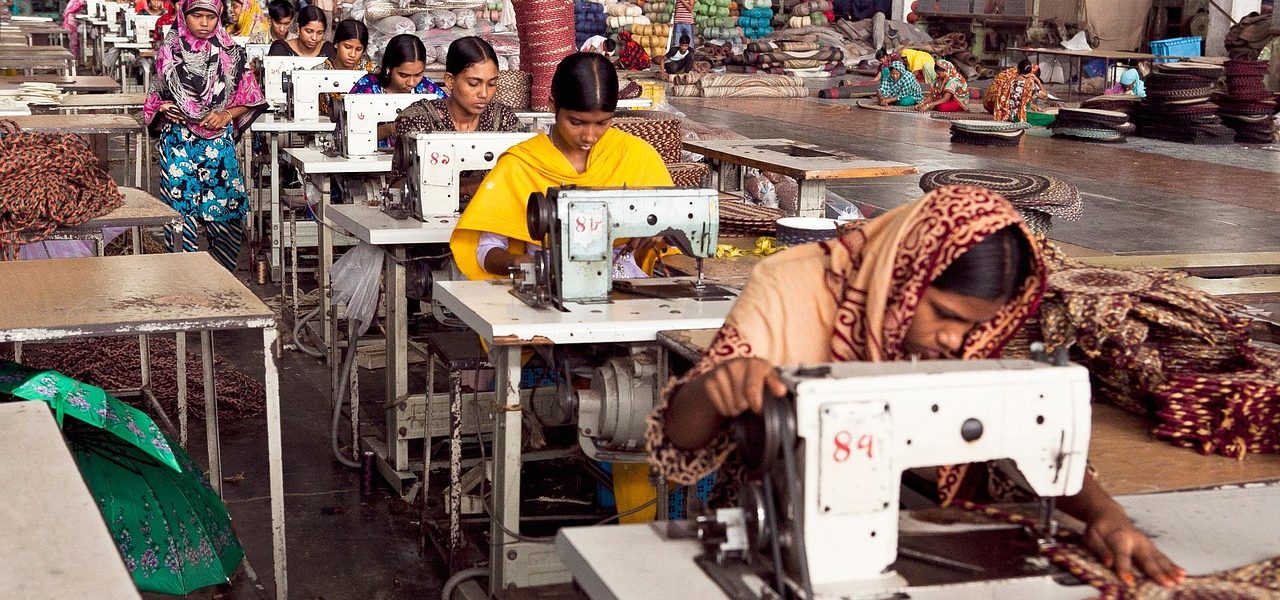The modern clothing industry is dominated by fast fashion companies like H&M, which release 52 “micro seasons” of cheap clothing each year, essentially launching a new trend each week. This is characteristic of fast fashion, one of the largest growing industries in modern capitalism. Under fast fashion’s business model, companies rapidly mass produce inexpensive clothing to capture the latest trends and bring them quickly to market. “Quantity over quality” defines the industry. To maintain low prices and sustain or increase profit margins, these companies depend on outsourcing production to developing countries, like Bangladesh, with low wages and minimal regulation (Guido, 2023).
While this system benefits corporations in wealthier countries, it comes at a large cost for developing countries, from the significant exploitation of workers to safety catastrophes and environmental and health degradation. It is developing countries, not the wealthy countries where the demand originates, that bear the economic and environmental brunt of fast fashion’s business practices.
The Economic Impact of Fast Fashion
Bangladesh is at the epicenter of this global fashion machine. It is a prime example and case study of a developing nation whose economy is deeply intertwined with fast fashion. The Bangladeshi fashion industry, nearly entirely fast fashion, accounts for approximately 20% of Bangladesh’s GDP and 90% of its exports (Helm, 2024). In Bangladesh, garment workers typically earn the minimum wage of 113 USD per month, far below the 302 USD per month estimated to be the nation’s living wage. In fact, only about 2% of international fast fashion workers make a living wage. International fashion brands pressure suppliers to cut costs, resulting in lower wages for workers (Saxena, 2023).
While fast fashion has contributed to economic growth, its large role in Bangladesh’s economy has created dependence on global demand rather than domestic, which has led to catastrophe such as when the supply chain is hindered during the COVID-19 crisis.
After the outbreak of the COVID-19 pandemic, lockdowns and store shutdowns led to a plunge in clothing demand. As this happened, many fast fashion brands halted production and cancelled orders in the factories they contracted with. In Bangladesh, more than $3.17 billion worth of orders were cancelled by April 2020, including orders already in production or finished and ready to be shipped (Saxena, 2020). This is despite their contractual obligation to pay. The result of these cancellations was the “partial or complete shutdown of thousands of factories in producing countries,” estimated to be about 58% of factories shutting down most or all operations when orders were cancelled (Anner, 2020).
More than 2.7 million garment workers in Bangladesh were either fired or temporarily suspended by April 2020, almost entirely without severance pay (Anner, 2020). By the end of May 2020, Bangladeshi workers had lost an estimated $502 million USD in wages. Similar trends emerged in other fast fashion producing countries (Reyes, 2021). This series of events shows the fragile nature of fast fashion’s global supply chains, with thin profit margins causing the refusal of following contractual obligations, harming economic stability in developing nations overall.
The Human Cost of Cheap Clothes
Worker safety is something else compromised by fast fashion’s cost-cutting. The hostile working environment created by fast fashion’s desire to maximize profits and fulfill consumeristic demand is exemplified in the 2013 Rana Plaza disaster. On April 23rd, dangerously large structural cracks were found in the eight story Rana Plaza building. Other businesses closed and evacuated their workers. But the garment factory owners, in which several international fast fashion brands produced their clothing, ordered the garment workers to come in the next day (showing fast fashion’s particularly exploitative nature in comparison to other industries).
On April 24th, thousands of workers went to work again in the unsafe Rana Plaza building, and hours later the entire building collapsed. 1,134 workers were killed, and 2600 workers were injured, many with lifelong injuries. Many of the survivors were trapped under tons of rubble and machinery for hours or even days before they could be rescued, sometimes only escaping by amputating their own limbs. The brands involved with the Rana Plaza garment factory included well-known fast fashion companies like Joe Fresh, Primark, and Benetton (Rana Plaza — Clean Clothes Campaign, n.d.). It is the very model of fast fashion – slim profit margins, to be increased at any cost – that caused factory owners to send garment workers to work in an unsafe building. Poor working conditions have led to injuries elsewhere, especially in the textile dyeing factories where, without protective equipment, dye chemicals and fumes can cause a plethora of negative effects and diseases.
Fast fashion’s environmental toll on developing countries is similarly severe. In Dhaka, Bangladesh, scientists have discovered extremely high levels of PFAS chemicals, “toxic forever-chemicals”, in tap and surface water. Some samples of water contained PFAS at more than 300x a proposed EU limit. The presence of PFAS has been directly linked to the fast fashion textile factories in the area. These factories use PFAS instead of other, safer chemicals as a cheap option for water, crease, and stain resistance in clothes. PFAS water contamination is linked to harmed fertility, impacted fetal development, weakened immunity, liver damage, and cancer (Hossain et al., 2024). For countries with limited healthcare resources, like developing countries such as Bangladesh where fast fashion is produced, this pollution leads to increased public health costs, reduced labor productivity, a sicker workforce, and greater human suffering.
Like many other developing countries, Bangladesh has environmental regulations on paper: textile factories must use treatment plants to filter wastewater before discharging it into rivers. But these treatment plants are expensive to install and run. The Bangladeshi government’s relatively high level of corruption means factory owners can pay off corrupt politicians or law enforcement to skirt regulations (Butler, 2025). Fashion firms maintain profit margins while the health and environmental costs are offloaded onto the local community and environment.
Both this environmental pollution and the neglect of safe working conditions stem from fast fashion’s economic logic, to cut costs with little regard for long-term harm. Without much regulation of either pollution or workplace safety, companies have essentially no economic incentive to invest in cleaner production methods or safer workplaces. In most cases, companies face little consequences for pollution or worker harm; meanwhile investing to avoid these harms increases production costs, which threatens thin profit margins (Guido, 2023).
Thus companies, in an economically rational but holistically negative calculation, prefer to ignore environmental harm or workplace danger in favor of greater profit, and the outcome is only logical and expected: environmental pollution as seen in Dhaka’s waterways, and safety catastrophe as seen in the Rana Plaza.
In response to growing criticism, many fashion companies have adopted or claim to have adopted Environmental, Social, and Governance (ESG) initiatives (Gunn, 2023). These are frameworks measuring how companies manage their environmental and social impact alongside quality of corporate governance. These policies are often ineffective for fast fashion, which operates in developing nations and needs low production costs to maintain profit. In other words, “fast fashion brands inherently rely on unsustainable practices to turn a profit.” As a result, many fast fashion companies resort to greenwashing to satisfy the public. That is, deceptively marketing their products as sustainable without implementing meaningful changes. Thus, fast fashion’s efforts to embrace ESG metrics, while putting on a face of good behavior to please consumers, largely fail to address the industry’s pressing issues (Remy & Speelman, 2023).
The Solution: Slowing Down?
One solution to the problems created by the fast fashion industry is a shift to “slow fashion.” This means basing clothing production on quality, durability, and reliability, rather than speed, disposability, and trendiness. This would mean returning to creating clothes out of quality material, with a longer process of production. Slow fashion has been proven to significantly reduce ecological footprints and foster fair labor conditions (Yusuff, 2024). Without such tight profit margins, wages could increase to levels more like living wage, and more resources could be invested in workers’ safety, ensuring stability by guaranteeing payment of contracts to factories, and investing more in environmental protections.
Likely the biggest force that can impact a shift to “slow fashion” is governments themselves (Yusuff, 2024). In producing countries like Bangladesh, they could strengthen labor laws and environmental regulations, while also cracking down on corruption; stronger regulations mean nothing without enforcement. Consuming countries should support policies encouraging production of slow and sustainable fashion, like tax incentives or subsidies for sustainable fashion. Tariffs or restrictions on garments that fail to comply with designated standards would also create economic pressure for fast fashion brands to change the way they do business. Consuming countries could also require that companies with factories in developing countries be in greater control of their supply chain, to hold them accountable. Investment in consumer education campaigns could encourage purchasing higher-quality and longer-lasting products.
These measures and pressures could encourage and incentivise companies to adopt slow and sustainable fashion models.
To mitigate the existing effects of fast fashion, third party organizations are to be a strong tool. The Accord on Fire and Building Safety and The Alliance for Bangladesh Worker Safety were created after the Rana Plaza disaster, and have succeeded in making a portion of Bangladesh’s factories structurally safer through factory inspections (Saxena, 2020). Still, the organizations have not reached a large number of factories and lack much power to enforce a larger change. Expanding their powers with government backing could improve factory safety significantly.
Unions can be a source of bottom-up empowerment for workers. In the Rana Plaza disaster, none of the victims were union members. Had the workers been organized into a union powerful enough to resist management pressure, the loss of life may have been avoided. Unions can represent the concerns of workers and protect them; they can advocate for fairer wages, safer workplaces, and job security, which are many of the things the fast fashion industry has ignored for profits (Saxena, 2020).
Meaningful change of the global fast fashion industry and a turn to a more sustainable, “slow fashion”, requires collective effort from governments, workers, third party organizations, businesses, and consumers. Through a coordinated effort, with pressure from the bottom and the top, the economic, environmental, and social costs of fast fashion can be mitigated. Then, we can have a better future for the developing countries at the heart of the global fashion economy.
References
Anner, M. (2020, March 27). Abandoned? The Impact of Covid-19 on Workers and Businesses at the Bottom of Global Garment Supply Chains. Center for Global Workers’ Rights.
Butler, S. (2025, March 26). Turning the tide on Bangladesh’s plastic pollution. Geographical Magazine. Retrieved July 18, 2025, from
https://geographical.co.uk/science-environment/turning-the-tide-bangladesh-plastic-pollution
Guido, A. (2023). Bangladesh and the Fast Fashion Industry: Injustices in the East & Profits in the West. Undergraduate Journal of Global Citizenship.
https://digitalcommons.fairfield.edu/cgi/viewcontent.cgi?article=1131&context=jogc
Gunn, K. (2023, January 3). Yellow Light: ESG Investing, A Caution to Fast Fashion Brands. Emory Law Scholarly Commons. Retrieved July 17, 2025, from https://scholarlycommons.law.emory.edu/cgi/viewcontent.cgi?article=1042&context=ecgar-perspectives
Helm, M. (2024, September 9). Beneath the Seams: The Human Toll of Fast Fashion – Earth Day. EarthDay.org. Retrieved July 18, 2025, from
https://www.earthday.org/beneath-the-seams-the-human-toll-of-fast-fashion/
Hossain et al., S. (2024, May). Persistent Threat: PFAS in Textiles and Water in Bangladesh. Environment and Social Development Organization and International Pollutants Elimination Network.
Rana Plaza — Clean Clothes Campaign. (n.d.). Clean Clothes Campaign. Retrieved July 18, 2025., from https://cleanclothes.org/campaigns/past/rana-plaza
Remy, N., & Speelman, E. (2023, April 21). GREENWASH DANGER ZONE. Greenpeace. Retrieved July 17, 2025, from
https://www.greenpeace.de/publikationen/Greenpeace_Report_Greenwash_Danger_Zone.pdf
Reyes, N. (2021, April 28). How the Pandemic is Affecting Bangladesh’s Garment Workers. Institute for Human Rights and Business. Retrieved July 18, 2025, from
https://www.ihrb.org/latest/how-the-pandemic-is-affecting-bangladeshs-garment-workers
Saxena, S. (2023, December 6). Achieving a living wage for garment workers needs price-squeezing to stop. Institute for Human Rights and Business.
Saxena, S. B. (2020, April 4). Bangladesh’s garment industry unravelling. https://chowdhurycenter.berkeley.edu/news/bangladesh%E2%80%99s-garment-industry-unravelling
Yusuff, M. (2024). Slow Fashion vs. Fast Fashion: Implications for Sustainability. Federal University of Technology.






